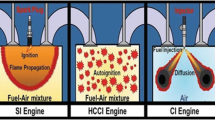Abstract
Finding an alternative fuel and reducing environmental pollution are the main goals for future internal combustion engines. Hydrogenmethane (HCNG) is now considered an alternative fuel due to its low emission and high burning rate. An experimental study was carried out to obtain fundamental data for the combustion and emission characteristics of pre-mixed hydrogen and methane in a constant volume chamber (CVC) with various fractions of hydrogen-methane blends. A pre-mixed chamber was used to obtain a good mixture of these gases. Exhaust emissions were measured using a Horiba exhaust gas analyzer for various fractions of hydrogen-methane blends. The results showed that the rapid combustion duration was shortened, and the rate of heat release elevated as the hydrogen fraction in the fuel blend was increased. Moreover, the maximum mean gas temperature and the maximum rate of pressure rise also increased. These phenomena were attributed to the burning velocity, which increased exponentially with the increased hydrogen fraction in the fuel blend. Exhaust HC and CO2 concentrations decreased, while NOX emission increased with an increase in the hydrogen fraction in the fuel blend. Our results could facilitate the application of hydrogen and methane as a fuel in the current fossil hydrocarbon-based economy and the strict emission regulations in internal combustion engines.
Similar content being viewed by others
References
F. Linch and Hythane, A bridge to an ultraclean renewable hydrogen energy system, Atti del Workshop IEA, Denver (1991).
S. K. Fulcher, B. F. Gajdeczko, P. G. Felton and F. V. Bracco, The effects of fuel atomization, vaporization, and mixing on the cold-start UHC emissions of a contemporary S.I. engine with intake-manifold injection, SAE Paper No. 952482 (1995).
S. R. Munshi, C. Nedelcu, J. Harris, T. Edwards, J. Williams, F. Lynch, M. Frailey, G. Dixon, S. Wayne and R. Nine, Hydrogen Blended Natural Gas Operation of a Heavy Duty Turbocharged Lean Burn Spark Ignition Engine, SAE Paper No. 2004-01-2956 (2004).
T. Iijima and T. Takeno, Effects of Temperature and Pressure on Burning Velocity, Combustion and Flame 65, Dept. of Mechanical Engineering, Faculty of Engineering, Tokai, Japan (1986) 35–43.
P. Grabner, A. Wimmer, F. Gerbig and A. Krohmer, Hydrogen as a Fuel for Internal Combustion Engines — Properties, Problems and Chances, 5th Intern. Colloquium FUELS (2005) 3–13.
T. Wallner, H. K. Ng and R. W. Peters, The Effects of Blending Hydrogen with Methane on Engine Operation, Efficiency, and Emissions, SAE Paper No. 2007-01-0474 (2007).
J. B. Heywood, Internal combustion engine fundamentals, McGraw-Hill, Inc., Massachusetts Institute of Technology, Massachusetts, USA (1988) 371–375.
Author information
Authors and Affiliations
Corresponding author
Additional information
This paper was recommended for publication in revised form by Associate Editor Ohchae Kwon
Seang-Wock Lee received his BS and MS in Mechanical Engineering in 1996 and 1998 from Kookmin University, and then the PhD in 2003 from Waseda University. He is a Professor at Kookmin University in Seoul, Korea. His research interests are in thermal dynamics, internal combustion engines, and alternative fuel engines.
Rights and permissions
About this article
Cite this article
Lee, SW., Lee, HS., Park, YJ. et al. Combustion and emission characteristics of HCNG in a constant volume chamber. J Mech Sci Technol 25, 489–494 (2011). https://doi.org/10.1007/s12206-010-1231-5
Received:
Revised:
Accepted:
Published:
Issue Date:
DOI: https://doi.org/10.1007/s12206-010-1231-5




